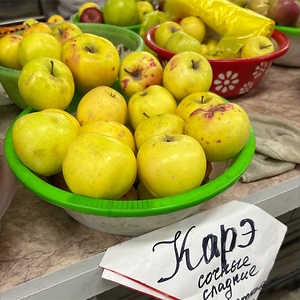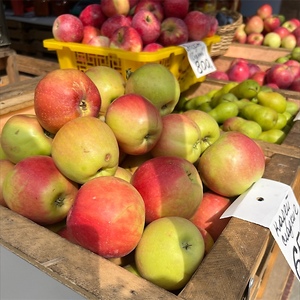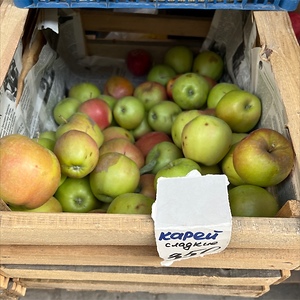


Korey Apples
Estimated Inventory, lb : 0
Description/Taste
Korey apples are a medium to large varietal, averaging 6 to 8 centimeters in diameter, and have an oblong to conical, sometimes flattened shape. The apples generally weigh between 120 to 200 grams and have a smooth, taut, thick, and slightly waxy skin with light ribbing and prominent dark lenticels. The skin also has a yellow-green base, ripening to a bright yellow hue with a red-orange, blurred blush on sides exposed to ample sunlight. Underneath the surface, the pale yellow to ivory flesh is dense, aqueous, and crunchy, encasing a small central core filled with tiny black-brown seeds. Korey apples release a faint, melon-like aroma when mature and have a sweet, mild, and subtly vinous flavor.
Seasons/Availability
Korey apples are available in the fall through early winter.
Current Facts
Korey apples, botanically classified as Malus domestica, are a Japanese variety belonging to the Rosaceae family. The late-season cultivar was developed in Japan in the early 20th century and was selected as a commercial variety for its sweet flavor and light, melon-like aroma. Korey apples are also known as Korei apples and are a self-fertile cultivar that grows on trees that reach 5 to 6 meters in height. The variety is not a widespread commercial apple and is only grown on a small scale among specialty orchards. Home gardeners also favor Korey apples, often planted in family gardens, landscapes, and orchards in Central Asia, Eastern Europe, and Japan. Growers value Korey apples for their extended storage capabilities, high yields, adaptability to cold weather, and drought tolerance. The variety has a mild and sweet flavor used in an array of fresh and cooked preparations.
Nutritional Value
Korey apples are a source of fiber to regulate the digestive tract, vitamin C to strengthen the immune system while reducing inflammation, and potassium to balance fluid levels within the body. The apples also provide vitamin K to assist in faster wound healing, manganese to promote calcium absorption, phosphorus to build strong bones and teeth, folate to develop healthy red blood cells, copper to build connective tissues, and contain other amounts of magnesium and calcium.
Applications
Korey apples have a dense, crisp, and juicy flesh suited for raw and cooked preparations. Ripe Korey apples have a mild and sweet flavor often consumed straight out of hand, or the fruits can be tossed into salads, fruit mixtures, and grain bowls. The apples can also be shredded into slaws, chopped into parfaits, mixed into oatmeal, or served with cheese on appetizer platters. In addition to consuming the fruits in slices, Korey apples have a sweet flavor that can be incorporated into juices, ciders, and smoothies. The apples can also be baked into cakes, pies, galettes, crisps, crumbles, and bread, cooked with browned butter to create a savory-sweet topping for ice cream, or sliced and dried for extended use. Beyond baked goods, Korey apples can be simmered into marmalades, jams, and jellies. Korey apples pair well with nuts such as walnuts, pecans, almonds, and pistachios, herbs including basil, mint, parsley, and rosemary, fruits such as strawberries, peaches, blueberries, and citrus, and spices including cloves, cinnamon, nutmeg, and allspice. Whole, unwashed Korey apples will keep for several weeks when stored in the refrigerator’s crisper drawer.
Ethnic/Cultural Info
Korey apples were developed in the Aomori Prefecture, one of Japan's most famous apple-producing regions. The Aomori Prefecture cultivates more than half of Japan’s apples, and of the 2,400 apple varieties grown in the country, approximately 50 are produced in Aomori. Apples were planted in the Aomori Prefecture around 1868, when political and cultural reforms led to the termination of the samurai. During this time, the Japanese government decided to create a program for the samurai to begin a new career in agriculture. In 1875, three different varieties of apple saplings grown from western varieties were given to families of the samurai to establish orchards. Aomori is located in the northern region of Honshu Island and is known as one of the coldest regions of Japan. It took the perseverance of the samurai to develop a sustainable orchard that would annually produce fruits, and over time, these orchards began to flourish. In the modern-day, the Aomori Prefecture draws international and domestic visitors, and the prefecture is themed with apple shops, restaurants, and u-pick orchards. The local spas also use apples to scent their hot spring waters. It is believed that the floating apples release malic, oleic, and linoleic acid into the water, contributing to softening the skin, hydrating, and increasing blood circulation. The Aomori Prefecture also creates apple-themed snacks to increase food tourism. Apples are popularly sliced and fried into apple chips, baked into apple pies on sticks, or pickled in syrup, wrapped in pastry dough, and baked into a branded dessert known as the “Curious Apple.”
Geography/History
Korey apples were developed in Japan at the Aomori Apple Experiment Station in 1935. The variety was created from a cross between Indo and Golden Delicious apples and was officially named in 1949. Apples were introduced to Japan in 1872, and the Japanese government selected 75 cultivars from the United States for cultivation. Over time, Japan continued to import an additional 900 varieties and began to develop its own cultivars through breeding stations such as the Aomori Apple Experiment Station, which has developed over 5,267 seedlings since its establishment in 1928. Today Korey apples are cultivated on a small scale in Japan and were also planted in Central Asia and the North Caucasus region in 1986, mainly in Dagestan, the Rostov region, and the Krasnodar territory.










